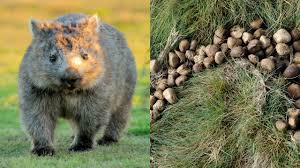Wombat cube poop is a biological marvel. It fascinates scientists and nature lovers. Specifically, wombats are the only known animals. They produce feces in a cubic shape. Moreover, this unique trait serves a purpose. It is not just a random quirk. Consequently, researchers have studied this phenomenon. This article explores the world of wombat cube poop.
Peculiarity of Wombat Cube Poop
Wombat cube poop is prculiar in nature. Mostly animals produce round or oval droppings. However, wombats defy this biological norm. They deposit small, block-shaped scat. This feature is unique to their species. For example, it helps in communication. The flat sides prevent the poop from rolling. This is important for marking territory. Thus, wombats can stack their poop high. This makes their presence known to others.
The cubes are surprisingly uniform. Each side is neat and well-defined. They look like they were made by a machine. But, this process is entirely natural. The wombat’s digestive system creates them. This incredible ability has puzzled scientists for years. As a result, many studies have been conducted. These studies reveal a complex biological process. It involves the wombat’s unique intestines.
Wombats are native to Australia. They are stout, burrowing marsupials. Their diet consists mainly of tough grasses. They have a very slow metabolism. Therefore, food takes a long time to digest. This long digestion time is a key factor. It helps in forming the wombat cube poop. The dry environment also plays a role. It leads to very dry fecal matter.
Why Wombat Cube Poop is Not a Myth
Some people find this fact hard to believe. Wombat cube poop sounds like a tall tale. However, it is a proven scientific fact. Zoos and wildlife sanctuaries showcase this. Visitors can see the cube-shaped droppings. Furthermore, extensive research confirms it. Scientists have dissected wombat intestines. They have studied the digestive process. Their findings explain how it is possible.
The firmness of the poop is important. The wombat extracts maximum moisture from food. This makes the feces very compact. The intestinal walls then shape it. The final product is a stackable cube. The shape is a clever evolutionary advantage. It helps wombats survive and communicate. So, while it seems strange, it is very real. The evidence for wombat cube poop is overwhelming.
The Science Behind Wombat Cube Poop
The secret to wombat cube poop lies within. It is in the wombat’s intestinal tract. The wombat intestine is very long. It can be up to 30 feet in length. The digestive process takes about 14 days. During this time, nutrients are absorbed. Also, water is thoroughly extracted. This results in very dry, firm feces.
The magic happens in the final section. The last part of the intestine is unique. It has areas of varying elasticity. Some parts of the wall are stretchy. Other parts are much stiffer. This variation in pressure sculpts the poop. As the fecal matter moves through, it is shaped. The intestine contracts and relaxes rhythmically. This pushes the contents along.
Imagine a soft material inside a tube. The tube has both soft and rigid sections. As you push the material, it changes shape. The rigid parts create flat sides. The softer parts allow for corners. This is a simple way to picture it. The wombat’s intestine works similarly. The process is a biological masterpiece. The final result is the famous wombat cube poop.
The Role of Intestinal Contractions in Wombat Cube Poop
Intestinal contractions are called peristalsis. These muscle movements push food through. In wombats, this process is highly specialized. The contractions are not uniform. They are stronger in some areas. They are weaker in others. This differential pressure is the key. The process was not fully understood until recently.
Scientists created a mathematical model. This model simulated the wombat’s gut. It showed how the varying elasticity works. It confirmed the creation of corners and edges. The intestine essentially has two stiff grooves. It also has two more flexible regions. These regions work together. They shape the poop over many cycles. A cube is formed by this process.
This discovery was a major breakthrough. It solved a long-standing biological puzzle. It showed nature’s incredible ingenuity. The wombat’s body is perfectly adapted. It turns digested grass into building blocks. These blocks are used for communication. Therefore, the intestine is a poop-shaping factory.
The Purpose of Wombat Cube Poop
Wombat cube poop serves several purposes. The primary function is communication. Wombats are solitary and territorial animals. They use their poop to mark their territory. They have very poor eyesight. Consequently, they rely heavily on smell. The poop acts as a chemical signpost. It tells other wombats who is around.

The cubic shape is a strategic advantage. Wombats like to place their droppings high up. They choose prominent locations. For instance, they use rocks, logs, or small mounds. A round dropping would simply roll off. The flat-sided wombat cube poop stays put. This ensures the scent-mark remains visible. It allows for effective territory marking.
Wombats can stack their cubes. This creates a more prominent signal. A taller pile of poop is more noticeable. It may signal a dominant or resident wombat. This helps avoid direct confrontation. Wombats can be aggressive with each other. Scent marking is a peaceful way to communicate. It helps maintain social order among them.
Wombat Cube Poop and Mating
Wombat cube poop also plays a role in mating. The feces contain chemical signals. These signals are called pheromones. They can indicate a wombat’s reproductive status. For example, a female in heat releases certain scents. A male wombat can detect these signals. This helps him find a potential mate.
This form of chemical communication is common. It is found in many mammal species. However, the wombat’s method is unique. The stackable nature of the poop is clever. It elevates the scent source. This allows the smell to travel farther. It increases the chances of being detected. In summary, wombat cube poop is a dating profile. It advertises availability to other wombats.
Research and Discoveries About Wombat Cube Poop
Research into wombat cube poop is ongoing. Scientists are still learning new things. Early studies focused on the diet. They thought the food source was key. However, this theory was incomplete. It did not explain the cubic shape. Later research shifted to anatomy. The focus became the wombat’s intestines. This led to the elasticity discovery.
A team of researchers won an Ig Nobel Prize. This award celebrates unusual scientific achievements. Their work on wombat cube poop was recognized. They showed how the cubes are formed. CT scans of wombats were used. They also measured the properties of the intestine. This work brought public attention to the topic. It highlighted a fascinating piece of biology.
Current research might have practical uses. Understanding the wombat’s gut could help humans. It could offer insights into digestive health. For example, it might help treat colon cancer. The way the intestine works is unique. It could inspire new medical technologies. The study of wombat cube poop could have unexpected benefits.
Future Studies on Wombat Cube Poop
Future studies will likely use advanced tech. High-resolution imaging can provide more detail. Genetic analysis might reveal more secrets. Scientists could identify the genes responsible. These genes would control intestinal properties. This would be a significant step forward.
Researchers also want to study different wombat species. There are three species of wombat. Do they all produce perfect cubes? Are there slight variations among them? Answering these questions adds to our knowledge. It helps us understand wombat evolution better.
Conservation is another important aspect. Wombats face threats in the wild. Habitat loss and disease are major problems. Studying their unique biology helps conservation. It helps us understand their needs. Protecting these amazing animals is vital. We must ensure they continue to produce their remarkable poop.
Conclusion: The Enduring Wonder of Wombat Cube Poop
In conclusion, wombat cube poop is amazing. It is a testament to nature’s creativity. This unique feature is not an accident. It serves a vital purpose for the wombat. The cubic shape helps in communication. It allows for effective territory marking. It also plays a role in finding mates.
The science behind it is just as fascinating. The wombat’s long, specialized intestine is key. It has regions of varying elasticity. These regions sculpt the feces into cubes. This process is a biological engineering feat. The research has solved a long-standing mystery. It also earned scientists an Ig Nobel Prize.
Wombat cube poop continues to intrigue us. It reminds us that nature is full of surprises. There is still so much to learn. Future research may reveal even more secrets. It could even have benefits for human health. Ultimately, the story of wombat cube poop is a great one. It shows how even the strangest traits have a purpose.
READ MORE; Tachysensia a dist……






